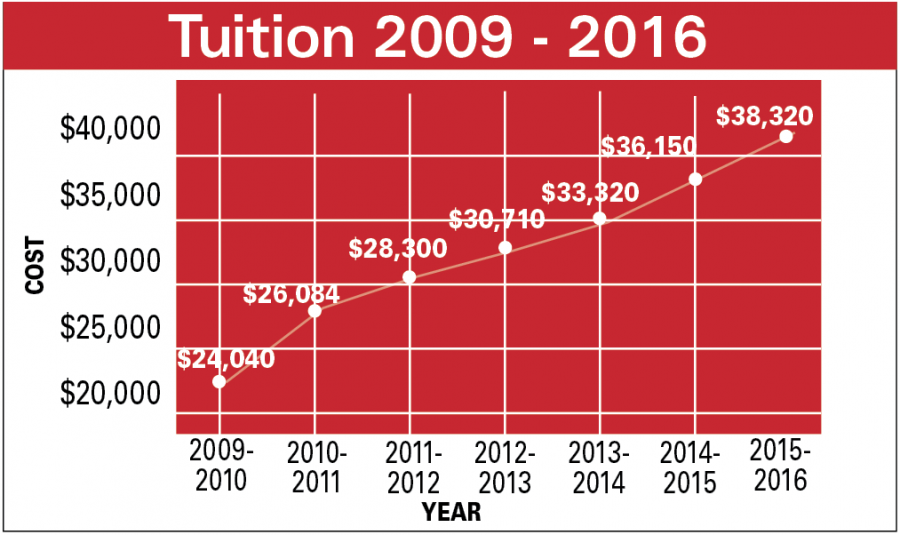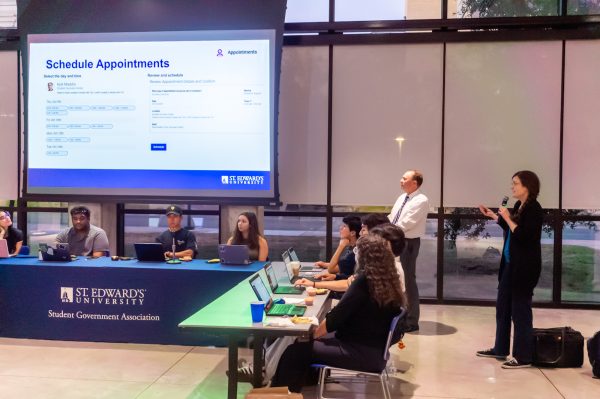Tuition nears $40,000 with 6 percent increase
St. Edward’s University is increasing its tuition to $38,320 for the 2015–2016 academic year to combat rising costs for the university, which lacks a strong endowment. This is a $2,170 or 6 percent increase from the rate for the current academic year.
“Tuition increases are necessary to offset rising expenses. St. Edward’s University is a tuition-dependent institution, meaning our primary revenue source is student tuition and fees, Kim Kvaal, vice president of Financial Affairs, said.
One of the largest components of St. Edward’s budget is financial aid, Kvaal said. Financial aid will be increasing by $8.5 million next year. The university will offer $58 million in scholarships.
“A substantial portion of resources are dedicated to scholarship support for meritorious and needy students,” Kvaal said.
When current juniors were freshman, the 2012-2013 year, tuition was $30,710. In the course of their undergraduate career, tuition has increased 24.8 percent.
Junior Matt Duerr said that he understands that the university needs to increase tuition.
However, that does not mean that he is not frustrated about the extra money that he now has to pay that he didn’t originally plan for.
“I’m going to have to bite the bullet with the money and just hope that I can take out an extra loan here for the last year and finish well,” Duerr said.
For the upcoming academic year, tuition is not the only rising expense. Housing has also gone up.
The exact increase in cost depends on the particular residence hall or apartment style. Alicia Vela, the director of Residence Life, also cited increasing expenses like utilities and property insurance for the rising housing rates.
To combat this issue and offer affordable on campus housing, Residence Life decided to offer a cheaper rate for some freshmen dorms and upper classmen apartments.
For the first time, some dorms will house three students, and some of the two-bedroom apartments will be reserved for four students.
The option with three students in a dorm will be available in East Hall, Edmund Hunt Hall and Lady Bird Johnson Hall. Students will pay $1,750, $2,510 and $2,900 respectively a semester.
The shared bedroom apartments will cost $3,250 a semester. Unlike the rest of the apartments, the share- bedroom apartments will come furnished with beds, dressers, desks and chairs for each student.
According to Vela, despite rising costs, more and more students want to live on campus each semester.
“The university is recruiting more out-of-state and international students that prefer to live on campus because they do not have a car, furniture, or do not know the area. It is safe and convenient to live on campus and close to everything that the university provides,” Vela said. “There are also specific programs and experiences that only students living on campus receive. Also, more local students are requesting housing due to the increase of traffic in the Austin area.”
Similar to the interest in on campus housing, the rising price of tuition at St. Edward’s has not curbed the rate of prospective students or harmed the university’s retention rate. In fact, the university retained 82.8 percent of freshmen from Fall 2013 to Fall 2014. That rate is the highest it has been in six years.
However, the rising tuition is affecting some prospective students. High school junior Hannah Fasching’s older sister, Heather, graduated from St. Edward’s in 2013. Because of Heather’s positive experience at St. Edward’s, Hannah decided that she wanted to go to St. Edward’s.
She hopes to attend St. Edward’s in the fall of 2016, but is concerned about the rising costs.
“I truly have a love for St. Edward’s and hope to attend if I can,” Hannah said.
According to Kvaal, 88 percent of first-time freshman receive some financial aid. The average amount is $27,074. This aid comes from federal, state, institutional and other scholarship funds. Kvaal urges any student who is struggling financially to meet with their financial aid advisor and update their FAFSA.
Kim Kvaal, vice president of Financial Affairs at St. Edward’s University, talked by email recently with Hilltop Views reporter Shelby Sementelli about the most recent tuition increase and university finances.
SS: Why is tuition rising for next year? Where is the extra money going?
KK: Tuition increases are necessary to offset rising expenses. St. Edward’s University is a tuition-dependent institution, meaning our primary revenue source is student tuition and fees, unlike a highly endowed institutions that receive substantial income from their endowment fund.
As a tuition-dependent institution, the two largest components of the budget are financial aid and salaries. A substantial portion of resources is dedicated to scholarship support for meritorious and needy students. Additionally, we want to attract and maintain excellent faculty and staff to deliver our mission. In order to do this, we must offer competitive salaries and benefits. Our campus facilities also play an important role in the SEU experience and require funding for repair, renewal, and renovation.
SS: I know that financial aid from the university increased by $7.7 million for this year. Will financial aid be increasing for next year? If so, by how much and where will that money come from?
University-funded financial aid (not including federal, state, or endowed scholarship funds) is increasing by $8.5 million, funded through the tuition increase and an expected larger freshman class.
SS: What is the average amount granted from the university to each student for the 2014-2015 academic year? How is this number expected to fluctuate for the next year?
KK: Eighty-eight percent of first-time freshman receive scholarship support or a grant. The average award is $27,074
SS: What is the university doing to retain students who might leave because of rising tuition rates?
KK: Retention is the highest it’s been in six years. Students who are struggling to pay their bills are encouraged to submit an updated FAFSA (Free Application for Federal Student Aid) and meet with their financial aid counselor.
SS: What is the university doing to attract potential students despite rising tuition rates?
KK: Interest in attending SEU is at an all-time high. We are experiencing record numbers of applications and campus visits. Each year, the university invests increasing amounts to financial aid to maintain and strengthen its commitment to access for all students. As mentioned above, SEU is increasing institutional-funded aid by $8.5 million next year.
SS: Do you think an education at St. Edward’s is worth the price tag? Why?
KK: Yes, I think the experience is invaluable and will be the best investment our students make in their lifetime.
SS: Do you believe the university is transparent about letting incoming students know that tuition can rise from year to year?
KK: It often comes up in conversations with prospective students and their families. The admission staff is proactive in disclosing [that] the tuition rate may increase in subsequent years.
SS: Tuition has increased every year in recent history. Can students expect that tuition will continue to rise in coming years?
KK: When we consider tuition increases, we look at the price our competitors are charging, the value of a SEU education, and the costs associated with delivering the SEU experience. We know that our student’s ability to pay will remain a key challenge and demand for financial aid will continue increasing. All of these factors affect tuition pricing. I cannot say what the future will bring but I can say we are committed to holding tuition increases to the lowest level possible given the demands on those dollars articulated above.
SS: Has the university ever considered guaranteeing a fixed tuition rate for a student’s four-year tenure at St. Ed’s?
KK: It’s been discussed in the past and determined that its not the right approach for St Edward’s. Many of the schools that have tried this pricing strategy have found that it didn’t work.
Follow Shelby for more!






